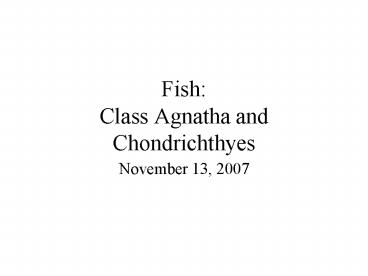Fish: Class Agnatha and Chondrichthyes PowerPoint PPT Presentation
1 / 22
Title: Fish: Class Agnatha and Chondrichthyes
1
FishClass Agnatha and Chondrichthyes
- November 13, 2007
2
Vertebrates
- What are the properties of vertebrates?
- Belong to the Chordates
- Vertebral column (spine, backbone)
- spine protects nerve cord
- the brain is at the anterior end of the spinal
cord, protected by skull
3
Fish
4
Class Agnatha
- Jawless Fish
- No Jaws
- Unpaired fins and no scales
- 2 Major Groups
- Hagfish
- Lampreys
5
Class Agnatha
- Hagfish
- 60 species
- Lack any trace of vertebrae
- Scavengers
- Secrete mucous
6
Class Agnatha
- Lampreys
- 40-50 species
- About a meter long
- Single nasal opening
- Large, well-developed eyes
- Parasitic
7
Class Agnatha
- Lampreys
- almost all are anadromous
- females produce hundreds to thousands of eggs
8
Class Chondrichthyes
- Cartilaginous fish
- Flexible, cartilage skeletons
- Movable jaws
- Paired and unpaired fins
- 2 Groups
- Holocephali (Chimeras)
- One gill opening on each side of the head
- Elasmobranchii (Sharks, Skates, and Rays)
- Multiple gill openings
9
Holocephali
- Chimeras or Ratfish
- 34 species
- Usually not over 1 m. in length
- Usually found deeper than 80 m.
- Move into shallow water to lay their eggs
- Most feed on shrimp, mollusks, and sea urchins
- Swim by undulating the body to wave the tail and
by fluttering their fins
10
Sharks
- 360 species
- 2 groups
- Squaloids
- 80 species
- Includes dogfish, basking shark, and megamouth
- Usually live in cold, deep water
- Galeoids
- 280 species
- Includes nurse shark, horn shark, whale shark,
great white, and hammerheads - The dominant carnivores of shallow, warm waters
11
Sharks
- General body shape
12
Sharks
- Size range
- Average 2 m. long
- Smallest shark - 25 cm.
- Deepwater Dogfish
- Largest shark - 60 m.
- Whale Shark
13
Sharks
- Skin
- A unique armor made up of placoid scales
- What is the benefit to having these scales?
14
Sharks
- Senses
- Olfaction
- Mechanoreception
- Vision
15
Sharks
- Ampullae of Lorenzini - Extra Sense
http//faculty.uca.edu/benw/biol4402/lecture7a/sl
d008.htm
16
Sharks
- Adaptations For Feeding
- Jaws
- Cranial Kinesis
- Shark teeth
17
Sharks
- Reproduction
- Internal fertilization
- Reproduction strategy?
- Modes of Reproduction
- Oviparous
- Ovoviviparous
- Viviparous
18
Sharks
- Social behavior
- Commercially hunted
19
Skates and Rays
- More diverse than sharks
- 456 extant species
- Probably evolved from the Squaloid sharks
20
Skates and Rays
- Adaptations
- Shape
- Color
- Pectoral Fins
- Electric Impulses
21
Skates and Rays
- Diet
- Most eat benthic invertebrates
- The largest are plankton strainers
22
Skates and Rays
- Differences Between Skates and Rays
- Tail
- Skates have an elongate thick tail with 2 dorsal
fins and a terminal caudal fin - Rays have a whip-like tail, and their fins are
replaced by one or more enlarged, serrated, and
venomous barb - Mode of Reproduction
- Skates are oviparous
- Rays are viviparous

